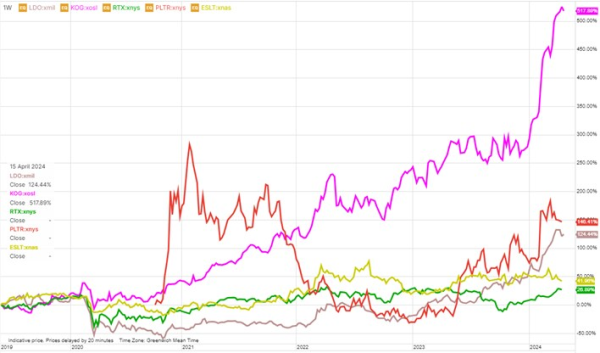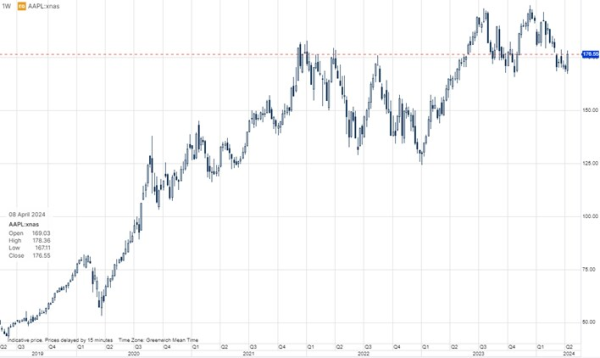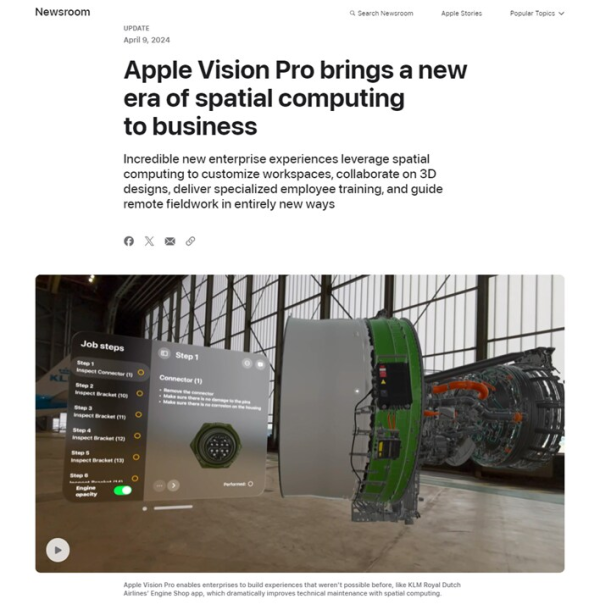What Iran attack means for air defence; iPhone loses market share
Key points
- Warfare evolution: Iran's recent attack on Israel underscores the need for updated defence technologies, as drone and missile swarms challenge traditional surface-to-air defence systems, prompting a demand for more efficient solutions.
- New air defence technology: Laser systems like the UK's DragonFire, combined with AI identification, present promising alternatives to conventional missile defence, driving investment interest in companies like Leonardo, poised to lead in next-generation defence technologies.
- Apple outlook: Despite a short-term decline in iPhone shipments, Apple's strategic focus on Services and the development of Vision Pro offer promising long-term investment prospects, reflecting its resilience and innovation in navigating market challenges.
Iran’s attack on Israel puts surface-to-air missile defence systems into focus
The weekend attack on Israel by a swarm of Iranian drones, ballistic, and cruise missiles was a new low point for geopolitics and underscores the uncertainties the conflicts in Ukraine and the Middle East have on investor portfolios. Instead of going into long details about the geopolitics of the weekend’s events, which is essentially just guessing, we want to focus on what it means for equities.
The war in Ukraine has changed the battlefield and warfare in the 21st century. It has often been called the “drone war” as drones are increasingly used to overwhelm the enemy’s air defence systems. By launching a swarm with the first layer being cheap unmanned aerial vehicle (UAVs) the defence system is overwhelmed and then the next layers are low altitude cruise missiles and high altitude ballistic missiles. The current surface-to-air defence systems such as the US-based Patriot system is expensive relative to the drone swarm and thus it is clear that new technology needs to be developed to mitigate this new threat. In the short-term, Iran’s attack is a stark reminder of the future warfare and we expect Europe to massively invest in surface-to-air defence systems. Below we have listed a number of defence stocks that could benefit from more resources being deployed towards air defence.
- Elbit – Israeli defence company that has collaborated on the Iron Dome project which is Israel’s multi-layered surface-to-air defence missile system.
- Kongsberg – manufacturer of the NASAMS surface-to-air missile system and one of the alternatives to the US based Patriot system. We expect the “Europe First” military doctrine to add significantly to demand of NASAMS.
- RTX (previously Raytheon) – manufacturer of the Global Patriot Solution which is the solution currently in demand in Ukraine.
- Palantir – the company is not revealing much about its government contracts but given its technical capabilities we expect the company to increasingly be involved in military applications including quick identification of incoming targets in the air.
- L3Harris – develops missile warning and defence systems including space technology for identification of incoming missile targets.

One of the technologies that are being explored to mitigate drone swarms are laser systems. Israel is exploring this technology and the UK is working on its DragonFire system that delivers high-power firing of a laser weapon against aerial targets. On 19 January 2024, the UK Ministry of Defence announced its first success with DragonFire. Firing DragonFire for 10 seconds has the same cost equivalent of using a regular heater for just an hour making it an attractive long-term low-cost alternative to current missile systems. One shot typically costs less than GBP 10. Combining high-power laser technology with AI identification and automatic launch capabilities could make this a very powerful defence technology that could also be used in Ukraine. When it comes to investing it becomes very interesting as the Italian based defence company Leonardo is responsible for 60% of the international market for high energy military lasers.
Global iPhone shipments are down 10%: Our take on the outlook for Apple
Apple shares rose 5.2% in the last two trading sessions of last week as the US technology company announced a revamped offering of M4 Macs with AI capabilities for debut late 2024 or early 2025. In addition, there were talks that hedge funds were beginning to look at Apple as its valuation had become too cheap to ignore. Apple is currently valued at a free cash flow yield of 4%.
IDC, a leading global market intelligence company, has announced this morning that it estimates that global iPhone shipments were down 9.6% in Q1 which is the worst slump since the Covid pandemic. Apple’s Q1 iPhone shipments were 50.1mn and translated into a global market share of 17.3% while the big winners were Xiaomi and Transsion (Chinese based manufacturer and market leader in Africa) seeing shipments up by 33.8% and 84.9% YoY respectively.
It is very disappointing figures for Apple given the first quarter was one of the best quarters for smart phones in years as the market is rebounding. Global smart phone shipments were up 7.8% YoY in Q1 according to IDC figures. A mitigating factor is that the majority of the decline comes from losing market share in the Chinese market with Apple shipping around 4.5mn less iPhones in the first two months of the year in China. With the Chinese economy challenged a premium phone like Apple will undoubtedly lose market share. How nervous should long-term investors be for Apple’s outlook?
As inflation is still lingering and economies such as Europe and China are still weak we think investors should put less weight on the short-term iPhone slump. Apple still has the highest quality offering in the marketplace and the Services segment is still expected to be the main driver of profitability in the medium term. The services segment has gone from being 20.4% of total gross profit in FY17 to 35.7% in FY23 (ending 30 September 2023) and will cross the 50% threshold within the next couple of fiscal years. On the operating profit side the services segment is already contributing over 50% of profits.
Longer term the big gamble by Apple is on its spatial computing platform Vision Pro which is a virtual reality and augmented reality headset. Apple’s decision to push the product first in the manufacturing sector is a good decision. As the screenshot below shows (from their recent press release on Vision Pro) spatial computing holds great promises for factory workers and in this case KLM airlines and their engine shop where maintenance can be improved dramatically with the Vison Pro. The press release from Apple holds other interesting use cases of the Vision Pro.
